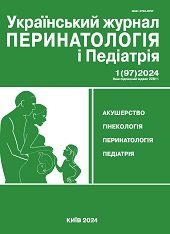Characteristic of epigenetic factors of fertile aged women residents of the Kyiv city of Ukraine who have undergone coronavirus infection
DOI:
https://doi.org/10.15574/PP.2024.97.17Keywords:
epigenetic factors, women, fertile age, risk factors, coronavirus disease, transferred coronavirus infectionAbstract
This study highlights the critical importance of understanding the impact of epigenetic risk factors on COVID-19 among women of fertile age.
Purpose - to characterize the epigenetic factors of COVID-19 in women of childbearing age, residents of Kyiv city who have had coronavirus infection, identified as a result of clinical and epidemiological studies.
Materials and methods. This research investigates the potential epigenetic risk factors for COVID-19 onset and progression in women of childbearing age in the Kyiv city. An original, comprehensive questionnaire designed to capture a wide range of health and socio-biological risk factors was disseminated among 100 women. Follow-up examinations and interviews were conducted with 97 of these women.
Results. The study revealed that a notable proportion of the surveyed women experienced adverse working conditions. 12.4% reported infrequent exposure to chemically harmful environments. About 12.4% indicated consistent and 10.3% intermittent work-related nervous strain. Furthermore, 15.5% of the respondents identified infrequent physical hazards at their workplace, while 19.6% experienced occupational harm. Among male partners, 4.1% frequent and 4.1% occasionally had contact with harmful vapours or chemicals at work. Epigenetic risk factors were determined using a clinical genealogical map. Occupational harm was absent before and after COVID-19 infection in 35.0% and 33.0% of women, respectively. Regarding harmful habits, 9.3% and 2.1% of women engaged in tobacco smoking before and after COVID-19 infection, respectively, whereas 9.3% and 36.8% did not consumed alcohol. Past illnesses, such as rubella and allergy, were identified as potential epigenetic factors in 3.1% and 11.3% of women.
Conclusions. It was established that among the identified epigenetic risk factors that can directly or indirectly affect the spread of coronavirus infection in women, residents of the city of Kyiv, the following require special attention of the doctor: presence of contact with physical and chemical agents, transferred diseases and conditions (rubella in 3.1 % of women), allergy (in 11.3% and 13.4% of women before and after the disease).
The research was carried out in accordance with the principles of the Helsinki Declaration. The study protocol was approved by the Local Ethics Committee of the participating institution. The informed consent of the patient was obtained for conducting the studies.
No conflict of interests was declared by the authors.
References
Atlante S, Mongelli A, Barbi V, Martelli F, Farsetti A, Gaetano C. (2020). The epigenetic implication in coronavirus infection and therapy. Clin. Epigenet. 12: 1-12. https://doi.org/10.1186/s13148-020-00946-x; PMid:33087172 PMCid:PMC7576975
Bonkowski MS, Sinclair DA. (2016). Slowing ageing by design: The rise of NAD (+) and sirtuin-activating compounds. Nat. Rev. Mol.Cell Biol. 17: 679-690. https://doi.org/10.1038/nrm.2016.93; PMid:27552971 PMCid:PMC5107309
CDC. (2019). Coronavirus (COVID-19). URL: https://www.cdc.gov/coronavirus/2019-ncov/index.html; (accessed on 18/06/2020).
Chen N, Zhou M, Dong X et al. (2020, Feb 15). Epidemiological and clinical characteristics of 99 cases of 2019 novel coronavirus pneumonia in Wuhan, China:a descriptive study. Lancet. 395 (10223): 507-513. https://doi.org/10.1016/S2215-0366(20)30078-X; PMid:32085839
Froidure A, Mahieu M, Hoton D, Laterre P-F et al. (2020). Short telomeres increase the risk of severe COVID-19. Aging. 12: 19911-19922. https://doi.org/10.18632/aging.104097; PMid:33104521 PMCid:PMC7655194
Gomez DE, Armando RG, Farina HG, Menna PL, Cerrudo CS, Ghiringhelli PD et al. (2012). Telomere structure and telomerase in health and disease (Review). Intern J Oncol. 41: 1561-1569. https://doi.org/10.3892/ijo.2012.1611; PMid:22941386 PMCid:PMC3583695
Livshits LA, Harashchenko TA, Umanets TR, Krasnienkov DS, Gorodna OV, Podolskiy VlV et al. (2021). Relationship between the Prevalence of ACE1 I/D Polymorphism Genotype II and Covid-19 Morbidity, Mortality in Ukraine and in Some Europe Countries. Cytology and Genetics. 55; 5: 427-432. https://doi.org/10.3103/S0095452721050054; PMid:34565928 PMCid:PMC8450713
Podolskyi VV, Antipkin YG, Podolskyi VlV, Umanets TR, Kaminska TM, Livshyts LA, Rudenko SA. (2021). Medico-social factors of the possibility of the spread of coronavirus infection among women of childbearing age. Reproductive endocrinology. 5 (61): 8-15. https://doi.org/10.18370/2309-4117.2021.61.8-14
Rudrapal M, Khairnar SJ, Borse LB, Jadhav AG. (2020, Sep). Coronavirus Disease-2019 (COVID-19): An Updated Review. Drug Res (Stuttg). 70 (9): 389-400. Epub 2020 Aug 3. https://doi.org/10.1055/a-1217-2397; PMid:32746481 PMCid:PMC7516369
Russo VEA, Martienssen RA, Riggs AD. (1996). Introduction. Epigenetic Mechanisms of Gene Regulation / N.Y.: Cold Spring Harbor Laboratory Press.: 1-4.
Sang E, Tian Y, Miller L, Sang Y. (2021). Epigenetic Evolution of ACE2 and IL-6 Genes: Non-Canonical Interferon-Stimulated Genes Correlate to COVID-19 Susceptibility in Vertebrates. Genes. 12: 154. https://doi.org/10.3390/genes12020154; PMid:33503821 PMCid:PMC7912275
Singhal TA. (2020, Apr). Review of Coronavirus Disease-2019 (COVID-19). Indian J Pediatr. 87 (4): 281-286. https://doi.org/10.1007/s12098-020-03263-6; PMid:32166607 PMCid:PMC7090728
Downloads
Published
Issue
Section
License
Copyright (c) 2024 Ukrainian Journal of Perinatology and Pediatrics

This work is licensed under a Creative Commons Attribution-NonCommercial 4.0 International License.
The policy of the Journal “Ukrainian Journal of Perinatology and Pediatrics” is compatible with the vast majority of funders' of open access and self-archiving policies. The journal provides immediate open access route being convinced that everyone – not only scientists - can benefit from research results, and publishes articles exclusively under open access distribution, with a Creative Commons Attribution-Noncommercial 4.0 international license(СС BY-NC).
Authors transfer the copyright to the Journal “MODERN PEDIATRICS. UKRAINE” when the manuscript is accepted for publication. Authors declare that this manuscript has not been published nor is under simultaneous consideration for publication elsewhere. After publication, the articles become freely available on-line to the public.
Readers have the right to use, distribute, and reproduce articles in any medium, provided the articles and the journal are properly cited.
The use of published materials for commercial purposes is strongly prohibited.

